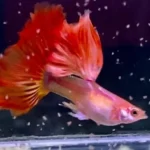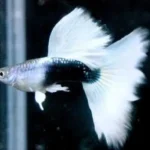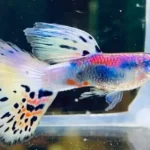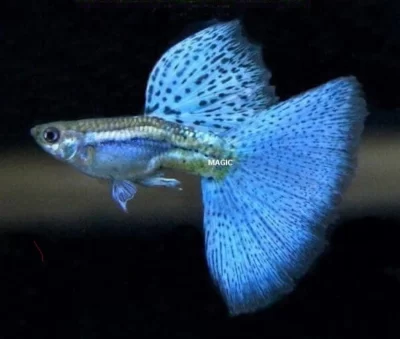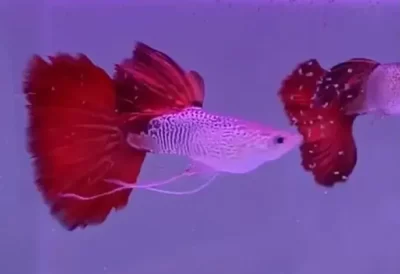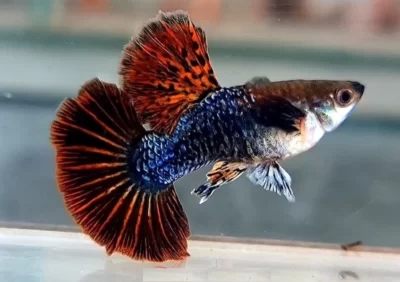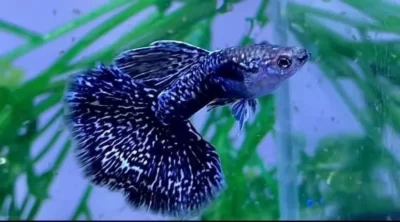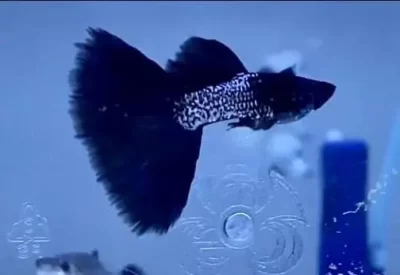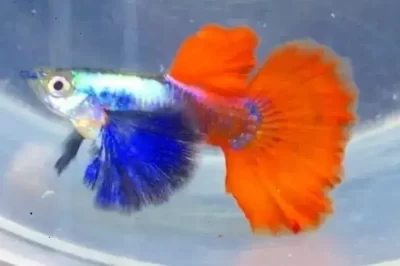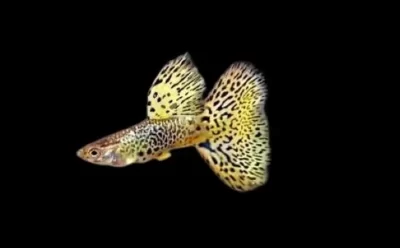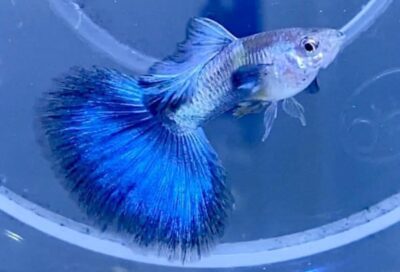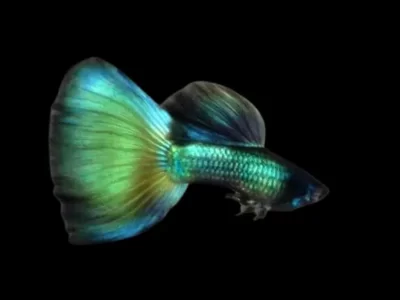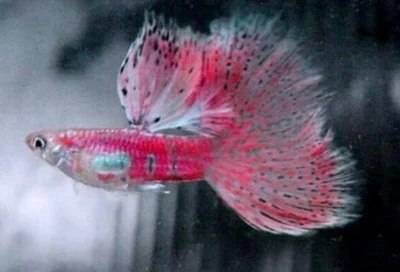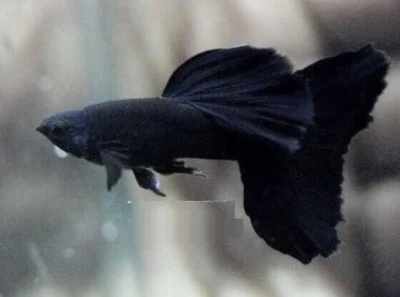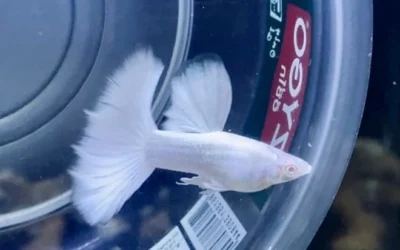Fancy guppies (Poecilia reticulata) are a selectively bred version of the common guppy. They are renowned for their vibrant colors, intricate patterns, and elaborate fins. Native to South America, fancy guppies are now one of the most popular fish in the aquarium hobby worldwide.
Whether you’re a beginner setting up your first tank or an enthusiast looking to breed new varieties, fancy guppies offer endless beauty and excitement. This guide covers varieties, care, tank setup, breeding, health tips and everything you need to know about these stunning fish.
1) Popular Varieties of Fancy Guppies
2) Why Fancy Guppies Are So Popular
3) Setting Up the Perfect Aquarium for Fancy Guppies
4) Diet and Feeding
5) Breeding Fancy Guppies
6) Common Health Issues and Solutions
Popular Varieties of Fancy Guppies:
Double Tail Fancy Guppies:
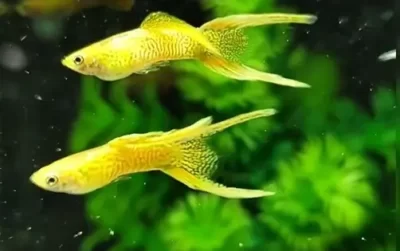
The double-tail fancy guppy, also known as the twin-tail guppy, is a specific variety of fancy guppy with a split or double tail. This unique characteristic sets them apart from other normal guppies.
Grass Tail Fancy Guppies:
The grass-tail guppy is one of the most common members of the Fancy Guppy variety. They are known for their large fins and tails which look like blades of grass.
The male blue grass guppy has a larger tail than the female ones, and they often look colorful.
Fantail Fancy Guppy:
Fantails fancy guppies have large fins and fan-shaped tails that spread out like a fan and are the most sought-after fancy guppies for their beautiful colors and various patterns.
Yellow pattern fantail fancy guppy:
Halfmoon Tail Fancy Guppy:
Halfmoon tails guppies boast tails that form a perfect semicircle, like a half-moon, when fully extended. Their vibrant colors and patterns make them truly outstanding.
Blue Half-Moon Tail Guppy:
Delta Fancy guppies:
Delta guppies refer to a specific tail type in guppies, which is triangular. Delta fancy guppies have tails that have sharp angles and the appearance of a triangle when the tail is fully spread.
Delta guppies, like other fancy guppy varieties, come in a wide range of colors and patterns. Guppy enthusiasts often like them for their vibrant and diverse coloration.
Dumbo Ear Guppies:
“Dumbo Ear” guppies also known as “Elephant Ear” guppies have enlarged pectoral fins, resembling the ears of an elephant.
The large pectoral fins are located on the sides of the fish and are significantly larger than those of regular guppies. Like other fancy guppies, Dumbo Ear guppies come in a wide range of colors and patterns.
Cobra Guppies:
Cobra guppies are a specific variety of fancy guppies that are known for their color patterns that resemble a cobra snake.
These guppies are selectively bred to exhibit vibrant and contrasting colors along their bodies and fins.
Metallic Guppies:
Metallic Guppies exhibit bright and shiny metallic-like colors, which add to the appeal of this popular fancy guppy variety.
Metallic guppies have scales that reflect light and give them a shiny or metallic appearance. The reflective quality of this fancy gives a bright look.
Sunrise Fancy Guppy:
The Sunrise Fancy Guppy is a visually stunning and highly sought-after variety of guppy fish, admired for its vibrant coloration that resembles the warm hues of a sunrise.

With their radiant gradient of yellow, orange, and red tones, Sunrise Guppies make a breathtaking addition to any freshwater aquarium.
Sunrise Guppies are named for their gradient coloring, which often transitions from golden yellow at the head to fiery orange and deep red toward the tail.
Pink Fancy Guppy
The Pink Guppy is a dazzling and unique variety of fancy guppies, adored for its soft, romantic hues that bring a touch of elegance to any aquarium. These guppies are highly sought after for their rare coloration and graceful appearance.
Pink guppies feature shades ranging from soft pastel pink to vibrant magenta, often accented with iridescent or metallic highlights.
Some may exhibit gradient tails blending pink with white or other subtle colors.
Blue Lace Guppy
The Blue Lace Guppy (Poecilia reticulata) is a beautiful freshwater fish known for its intricate lace-like patterns and mesmerizing blue coloration. It is highly sought after by aquarists. This guppy variety is prized for its elegance, peaceful temperament, and ease of care.
Blue Lace Guppies exhibit a unique blend of deep blue shades with delicate, web-like patterns across their fins and body. Their long, flowing tails add to their beauty, creating a stunning visual display in any aquarium.
Pink Grass Guppy
The Pink Grass Guppy (Poecilia reticulata) is a stunning freshwater fish known for its delicate pink hue and fine, grass-like patterns on its tail and fins. This guppy variety is highly prized by hobbyists due to its vibrant coloration, hardy nature, and easy breeding habits.
Pink Grass Guppies have a soft pink or peach-colored body with grass-like markings on their caudal and dorsal fins. Their long, flowing tails create a mesmerizing effect as they swim gracefully through the water.
Yellow Tuxedo Guppy
The Yellow Tuxedo Guppy (Poecilia reticulata) is a stunning guppy variety known for its bright yellow body contrasted with a dark “tuxedo” pattern on its lower half. This eye-catching coloration makes it a favorite among aquarists.
Yellow Tuxedo Guppies have a golden-yellow front half, while the rear half is deep black or dark blue, resembling a tuxedo suit. Their tails may feature additional patterns or gradients, enhancing their beauty. Males are typically more colorful and have elongated, flowing fins, while females are slightly larger and less vibrant.
Full Black Fancy Guppy
Full Black Fancy Guppy is the Elegance of Darkness in Your Aquarium. The Full Black Guppy (Poecilia reticulata) is a stunning and sophisticated guppy variety known for its deep, velvety black coloration that covers its entire body and fins. Highly sought after by guppy enthusiasts, this fish brings a bold, dramatic contrast to any aquarium.
Full Black Guppies exhibit a rich, uniform black coloration and sometimes with a glossy, almost metallic sheen. Males have long, flowing fins, while females tend to be larger with a slightly less intense black hue. Their solid black color makes them stand out beautifully in well-lit tanks.
White Tiger Fancy Guppy
The White Tiger Guppy is a Unique and Elegant Aquarium Fish. The White Tiger Guppy (Poecilia reticulata) is a stunning and rare guppy variety known for its white base color with intricate tiger-like patterns on its body and fins.

White Tiger Guppies feature a pale white or silver body adorned with dark stripes or spots, resembling a tiger’s markings. Their fins are often long and flowing, with a mix of white, black, and translucent shades. Males are more colorful and have elaborate fin patterns, while females are larger with a slightly subdued coloration.
Metallic Blue Fancy guppy
The Metallic Blue Guppy is a Shimmering Jewel for Your Aquarium. The Metallic Blue Guppy (Poecilia reticulata) is a breathtaking guppy variety known for its blue coloration that shimmers under aquarium lighting. Its unique metallic sheen and graceful movement make it a popular choice for guppy enthusiasts and beginner aquarists alike.
Metallic Blue Guppies feature a brilliant blue body with a metallic finish, reflecting light in a dazzling manner. Some varieties have solid blue tails, while others display a mix of black, silver, or translucent patterns. Males typically have more intense coloration and longer, flowing fins compared to females.
White Fancy Guppy
The White Fancy Guppy (Poecilia reticulata) is a stunning and graceful freshwater fish known for its pure white coloration and flowing fins.
Why Fancy Guppies Are So Popular
Bright and Beautiful Colors
Fancy guppies come in a rainbow of colors and shades such as reds, blues, greens, and even metallic tones. Each one is like a living jewel.
Low Maintenance
Perfect for beginners, Fancy guppies thrive in standard freshwater aquariums with minimal care.
Active and Peaceful Nature
They’re active swimmers and get along well with other peaceful fish, making them great for community tanks.
Affordable and Widely Available
Despite their beauty, fancy guppies are budget-friendly and easy to find in pet stores or online.
Setting Up the Perfect Aquarium for Fancy Guppies
Creating a comfortable home for your fancy guppies is essential for their health and happiness. Here’s what you’ll need:
Tank Size: A 10-gallon tank is suitable for a small group of fancy guppies, but bigger is always better.
Water Parameters:
Temperature: 72–82°F (22–28°C)
pH: 6.8–7.8
Hardness: Moderate to hard water (8–12 dGH)
Filtration and Aeration: Use a gentle filter and ensure adequate oxygen levels with an air pump.
Decor: Add live plants like Java moss for hiding spots and breeding.
Lighting: Moderate lighting enhances their colors without stressing them.
Diet and Feeding
Fancy guppies are omnivores and they thrive on a balanced diet consisting of:
-High-quality flakes or micro pellets designed for tropical fish
-Live or frozen foods like brine shrimp, daphnia, and bloodworms
-Blanched veggies like spinach or zucchini occasionally
Feed them small portions twice a day, ensuring that there are no leftover foods that can cloud the water.
Breeding Fancy Guppies
Breeding fancy guppies is one of the easiest and most rewarding parts of keeping them. They are livebearers, meaning that the females give birth to free-swimming fries at least once a 45 days. Fancy guppies can breed a batch of 15 to 45 fries.
Here’s how to get started for breeding:
Identify Male and Female Guppies:
Males: Males look Smaller, and have brighter colors and elongated fins.
Females: Females look Larger, and duller in color with rounder bodies.
Create a Breeding Tank:
Use a 5–10 gallon tank with plenty of plants.
Maintain the same water parameters as the main tank.
Watch for Pregnancy:
A dark gravid spot near the female’s tail indicates she’s pregnant. Gestation lasts about 21–30 days.
Separate the Fry:
After birth, move the fry to a nursery tank to protect them from being eaten. Feed them finely crushed flakes or baby brine shrimp.
Common Health Issues and Solutions
Fin Rot: It is caused by poor water quality; treat with clean water and antibacterial medications.
Ich (White Spot Disease): Treat with aquarium salt and temperature adjustment.
Swim Bladder Problems: Often due to overfeeding; fast the fish for a day or two.
Regular water changes and proper feeding routines can prevent most health issues.
Final Thoughts
Fancy guppies are more than just aquarium fish. They are tiny, living works of art. With the right setup, diet, and care, they will reward you with years of vibrant beauty and lively activity. Whether you’re fascinated by their patterns, interested in breeding, or simply want a colorful, low-maintenance fish, fancy guppies are the perfect choice.

